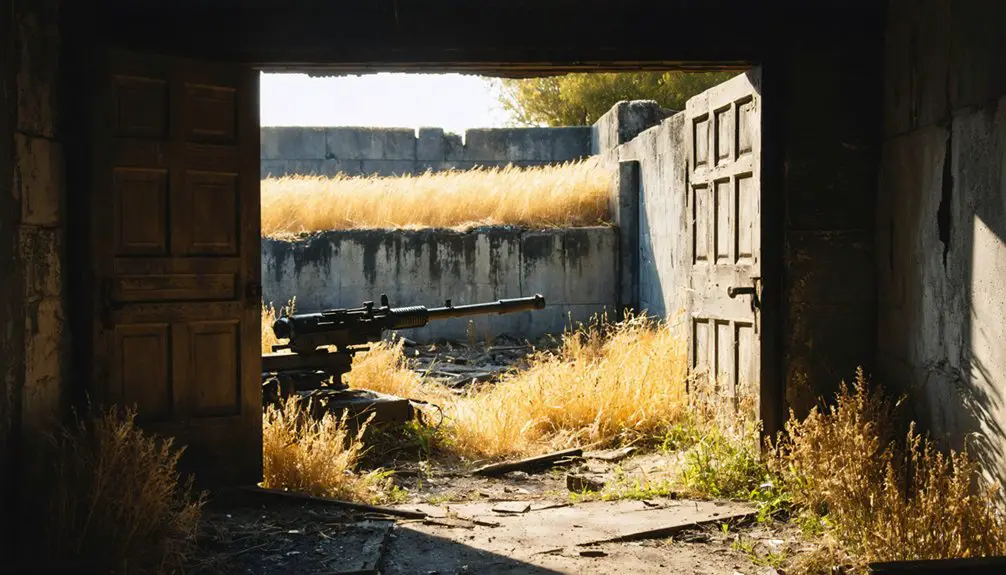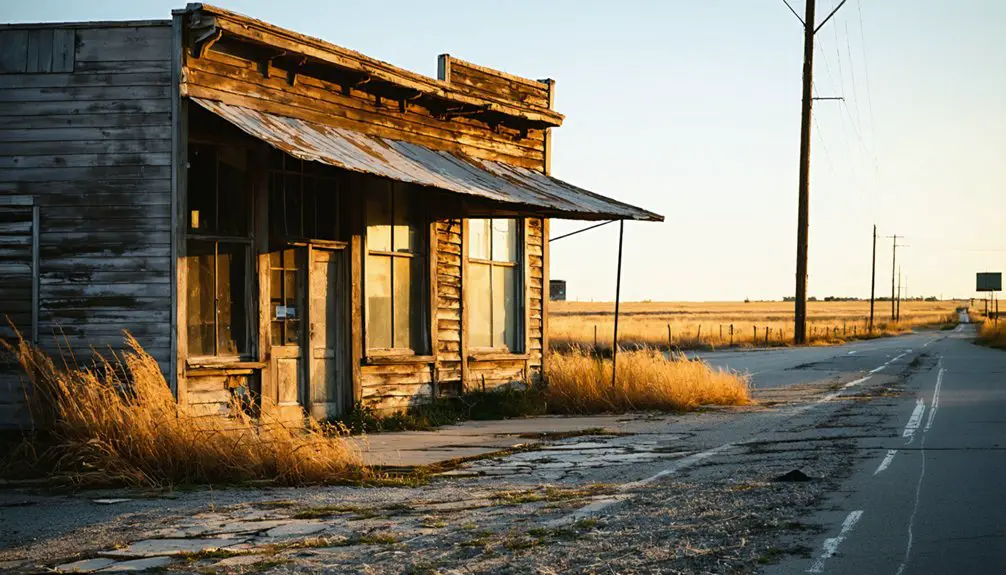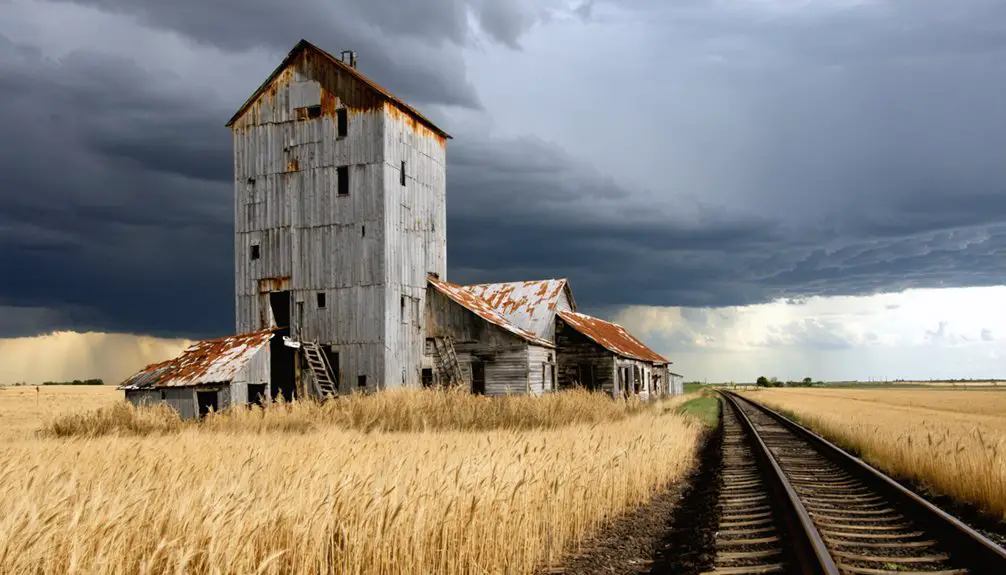You’ll find Eustis among Kansas’s most dramatic ghost towns, established in 1885 as a Burlington & Missouri River Railroad hub. Named for railroad agent P.S. Eustis, the town briefly served as Sherman County’s temporary seat in 1886 before losing that status to Goodland in a violent 1887 conflict that required National Guard intervention. Once home to Swedish, German, and Austrian immigrants, its buildings emptied as residents migrated to Goodland, leaving only prairie where a bustling frontier town once stood.
Key Takeaways
- Eustis was established in 1885 by the Lincoln Land Company as a railroad town named after P.S. Eustis of Burlington Railroad.
- The town briefly served as Sherman County’s temporary seat in 1886 before losing the position to Goodland following violent disputes.
- Armed conflicts erupted over county records, requiring Kansas National Guard intervention to restore order between Eustis and Goodland.
- After losing county seat status, residents gradually migrated to Goodland, leading to Eustis’s economic decline and eventual abandonment.
- The ghost town symbolizes failed frontier settlements, with only prairie remaining where buildings and railroad infrastructure once stood.
The Birth of a Railroad Town
When the Lincoln Land Company laid out Eustis in spring 1885, they envisioned a thriving railroad hub along the Burlington & Missouri River Railroad‘s expanding line.
You’ll find the town’s very name reflects its railroad connections – it was christened after P.S. Eustis, a key agent for the Burlington & Missouri River Railroad who, along with O.R. Phillips, organized the Lincoln Land Company.
As railroad traffic increased, town infrastructure quickly followed. By July 1886, you could visit the newly established post office, and travelers found comfort at the Eustis House hotel, which opened its doors in 1885. Many foreign immigrants from Europe helped establish the growing town.
The railroad’s presence attracted investors and settlers, transforming what was once empty prairie into a bustling commercial center designed to serve the steady stream of rail traffic. After Sherman County’s organization in September 1886, Eustis achieved a new level of prominence as the temporary county seat.
Early Settlement and Development
If you’d visited Eustis in 1885, you’d have found P.S. Eustis and O.R. Phillips laying out their dream town through the Lincoln Land Company amid the rolling Kansas prairie.
Foreign immigrants from Sweden, Germany, and Austria soon arrived, establishing homesteads and contributing to the town’s early growth.
The settlement quickly gained prominence when it was named Sherman County’s temporary seat in 1886, prompting the construction of a courthouse and essential municipal buildings. Like many Kansas settlers, the first residents of Eustis lived in primitive dugout homes while establishing their new community.
Railroad Spurs Town Growth
As the Burlington & Missouri River Railroad expanded across Kansas in the 1880s, its strategic placement of rail spurs catalyzed the birth of numerous settlements, including Eustis.
You’ll find that railroad influence shaped every aspect of the town’s early development, as P.S. Eustis and O.R. Phillips, both railroad agents, laid out the community in 1885.
The rail connection proved vital to Eustis’s rapid growth, attracting settlers and businesses enthusiastic to capitalize on improved transportation access. Like many Kansas towns of the era, land value increased significantly with the arrival of the railroad.
Town infrastructure quickly emerged around the railroad, with a post office established by July 1886. The town’s development mirrored the era when standard railroad gauges were being implemented across the country in 1883.
The spur’s presence strengthened Eustis’s bid to become Sherman County’s seat, highlighting how rail access could transform a new settlement into a center of political and economic power.
Pioneer Dreams Take Shape
Once the Lincoln Land Company laid out Eustis in spring 1885, the settlement quickly became a magnet for ambitious pioneers seeking new opportunities in Sherman County.
You’d have found a diverse mix of Swedish, German, and Austrian immigrants drawn by the promise of free or cheap land, ready to apply their farming and ranching expertise to the Kansas prairie. The Homestead Act allowed settlers to claim 160 acres of productive farmland in the region. Like many early Kansas settlers, they initially faced difficulties with hard winter wheat cultivation but eventually adapted their farming methods.
Pioneer motivations centered on building a new life, while settlement challenges pushed these hardy folks to adapt quickly. They constructed homes from local materials and established essential services, including a post office by July 1886.
When Sherman County organized that September, Eustis claimed the temporary county seat, sparking a series of heated elections. The town’s early success led to courthouse construction and the formation of the Sherman County Immigration Association, which actively recruited more settlers to the area.
The Fight for County Seat Status
When Sherman County officially organized on September 20, 1886, Eustis gained temporary status as the county seat, igniting an intense political battle among frontier towns.
You’ll find the competition for county seat status was fierce, with Eustis facing challengers from Goodland, Sherman Center, and Voltaire. Political intrigue ran deep as multiple sets of county officers operated from different towns, creating chaos in public affairs. Like many Kansas towns that experienced economic depressions, Eustis struggled to maintain its prominence and influence.
When a county committee arranged an election in 1887, Goodland emerged victorious. Eustis’ residents wouldn’t surrender easily, though, clinging to county records and refusing to acknowledge the results.
The situation reached its climax when Goodland’s officials hired armed men to seize the records from Eustis. This type of conflict mirrored the tensions seen between Springfield and Fargo Springs, where planned attacks nearly erupted over a similar county seat dispute. Unable to maintain their position, Eustis’ citizens eventually abandoned their town and moved to Goodland, marking the beginning of Eustis’ decline into a ghost town.
Armed Conflict and Political Tension
The political rivalry between Eustis and Goodland reached dangerous heights in late 1887, transforming from bureaucratic disputes into armed confrontation.
As community divisions deepened, Goodland hired armed cowboys to seize county records from Eustis, even capturing a county commissioner to force compliance.
While no shots were fired, the threat of violence prompted Governor John Martin to deploy the Kansas National Guard under Major General Adam Dixon and Captain Frank McGrath.
Similar to the stockade incident between Empire City and Galina, these neighboring towns engaged in physical barriers and confrontations to block movement between communities.
You’ll find that competing newspapers fanned the flames of discord through inflammatory articles, while multiple disputed elections and conflicting commissioner meetings created administrative chaos.
The situation reached its climax on January 13, 1888, when armed groups confronted each other over the records.
Military Intervention in Sherman County

In January 1888, Governor Martin dispatched Major General Adam Dixon and Captain Frank McGrath of the Kansas National Guard to Sherman County to quell rising tensions between Eustis and Goodland over the county seat dispute.
You’ll find that their primary mission focused on securing essential county records and maintaining order between the rival towns’ factions.
The military’s presence proved decisive, as by May 10, 1888, their intervention had helped end Eustis’ claim to the county seat, solidifying Goodland’s position as the administrative center.
National Guard Arrives
During escalating tensions of the Kansas County Seat Wars, National Guard units arrived in Sherman County to restore order and protect public safety.
You’d have seen soldiers from the Kansas Army National Guard establishing security perimeters around contested government buildings while maintaining radio contact with emergency management teams.
These trained peacekeepers didn’t replace local law enforcement but worked alongside them during the civil unrest.
You would’ve noticed Guard personnel conducting 24/7 patrols, monitoring demonstrations, and securing critical county facilities. Their presence acted as a powerful deterrent against violence, allowing public officials to resume their duties and voters to participate in local governance safely.
The Guard’s intervention effectively prevented wider armed conflict and helped restore normalcy to Sherman County’s communities.
Armed Conflict Prevention Efforts
Recognizing escalating tensions between Eustis and Goodland factions, Governor Martin dispatched Major General Adam Dixon and Captain Frank McGrath with National Guard troops to Sherman County in late 1887.
You’d have witnessed growing concerns about community defense as the Homesteaders Union Association purchased Winchester rifles and organized thirteen lodges across the county.
The National Guard’s presence proved essential in preventing armed clashes between the rival towns while protecting county records from seizure.
Though local newspapers stoked fears with inflammatory coverage, the military intervention successfully maintained order until May 1888.
Rather than erupting into violence, the conflict’s resolution through official channels demonstrated effective conflict resolution, ultimately securing Goodland’s position as the county seat.
The Exodus to Goodland
After Goodland secured its victory as the county seat through both legal battles and armed confrontation, Eustis residents faced a stark choice about their future.
With their town’s administrative importance stripped away and their legal options exhausted by May 1888, you’d have witnessed a steady Eustis migration toward the emerging victor. The town’s population dwindled as families packed up their lives and relocated to Goodland, drawn by its promising location along the Chicago, Rock Island and Pacific Railroad.
This Goodland settlement pattern accelerated as commercial opportunities followed the county’s administrative center. While some might’ve resisted initially, Eustis’ fate was sealed – its buildings emptied, its streets quieted, and its once-bustling community faded into the Kansas prairie, leaving behind only memories of the county seat war.
From Bustling Town to Empty Prairie

The bustling frontier town of Eustis emerged with promise in September 1886, when Governor John A. Martin established it as Sherman County’s temporary seat.
You’d have seen a determined community racing to build their courthouse and establish local government, fighting to maintain their political power through two successful elections.
But you wouldn’t find Eustis on today’s map. Without essential railroad expansion and facing mounting economic challenges after losing its county seat status to Goodland in 1888, the town couldn’t sustain itself.
The loss of administrative jobs and government-related commerce triggered an exodus of residents. One by one, buildings fell into disrepair, and the prairie slowly reclaimed the land.
Today, if you visit the site, you’ll find empty grassland where a vibrant frontier town once stood.
Regional Immigration and Cultural Heritage
While Eustis emerged as Sherman County’s temporary seat in 1886, its social fabric was woven from diverse European immigrant threads.
You’ll find that German, Swedish, and Austrian settlers made up a significant portion of the area’s 8.9% foreign-born population by 1900, drawn by the promise of affordable or free land.
These immigrant contributions shaped the region’s identity through their customs and social structures.
The diverse customs and traditions brought by European immigrants became woven into the very fabric of Sherman County’s cultural identity.
While African Americans were migrating to other parts of Kansas during the Exoduster Movement, Sherman County remained largely European in its cultural blending.
The Sherman County Immigration Association actively promoted settlement, helping establish a distinctly European character in towns like Eustis.
Despite the harsh prairie conditions, these immigrant communities maintained their cultural heritage until the town’s eventual decline.
Legacy of Kansas County Seat Wars

You’ll find that Eustis’ decline was directly tied to the violent county seat wars that plagued Kansas in the late 1800s, as rival towns formed armed posses to defend their claims through force.
The political power struggles often involved fraudulent elections and manipulation of legal processes, with both local officials and state authorities clashing over legitimacy.
These confrontations disrupted community development and delayed crucial infrastructure investments, ultimately contributing to Eustis’ transformation into a ghost town.
Political Power Struggles
During Kansas’s territorial and early statehood period, bitter political power struggles emerged as economic elites and established political leaders fought for control over county seats, including the area that would become Eustis.
You’d find political factions using every trick imaginable – from bribing voters with cash payments of up to $500 to stuffing ballot boxes and falsifying voter rolls. Wealthy railroad investors and local powerbrokers battled established politicians through election manipulation, legal challenges, and media propaganda wars.
The conflicts often landed in court, where rival groups submitted thousands of pages of legal documents alleging fraud and irregularities.
Local newspapers became battlegrounds of accusations and counter-accusations, while county clerk offices turned into strategic control points for maintaining power over electoral records and tax revenues.
Armed Confrontations Over Control
The political power struggles in Kansas territory eventually erupted into armed violence, as exemplified by the infamous Battle of Cimarron on January 12, 1889.
You’ll find that this brutal gunfight stemmed from Ingalls’ attempt to forcibly seize county records from Cimarron’s courthouse, led by Bill Tilghman and other former Dodge City lawmen.
The gunfight dynamics were intense, with both sides shooting to kill. Raiders found themselves trapped on the courthouse’s second floor while Cimarron’s residents fought back fiercely.
The battle lasted hours, leaving at least one dead and seven wounded. This wasn’t just about paperwork – the county seat designation meant economic survival for these frontier towns.
Such armed confrontations became a common feature of Kansas county seat wars, reflecting the high stakes of territorial control.
Sherman County’s Lost Communities
While Sherman County’s early development saw numerous ambitious settlements spring up in the 1880s, most of these pioneer communities eventually faded into ghost towns.
You’ll find these lost communities scattered across the county’s history, each with its own tale of hope and eventual decline.
- Sherman Center competed for county seat status in 1886, built on the site of an earlier ghost town.
- Voltaire, in northeast Goodland, couldn’t survive the Great Blizzard of 1886 and closed its post office by 1889.
- Gandy, founded in 1885 and named after Dr. J.L. Gandy, lost its significance to Goodland.
- Itasca’s brief existence ended when it failed to establish lasting roots.
- Ruleton joined the ranks of lost communities despite early promise.
These settlements’ struggles reflected the harsh realities of frontier life, where weather, politics, and economic forces determined survival.
Frequently Asked Questions
What Happened to the Original Buildings and Structures in Eustis?
You’ll find Eustis building history shows structures were abandoned when residents moved to Goodland. Buildings experienced structural decay, eventually collapsing or being dismantled, with materials possibly repurposed locally, leaving no remains today.
Are There Any Surviving Photographs of Eustis During Its Peak?
Like scattered gold dust from a forgotten mine, you’ll find few surviving Eustis photographs. A rare cabinet photo from the 1880s proves the town’s peak history, but most visual records haven’t endured time.
Did Any Descendants of Eustis Residents Remain in Sherman County?
You’ll find descendant research challenging since no clear records track Eustis families specifically, though family stories suggest some residents stayed in Sherman County, particularly moving to Goodland after 1888’s county seat loss.
What Was the Exact Population of Eustis Before Its Abandonment?
Like footprints in shifting sand, Eustis population records have vanished with time. You won’t find an exact number in the history books – official records were lost during the town’s hasty abandonment.
Are There Any Visible Remnants or Markers at the Former Townsite Today?
You won’t find any visible structures or historical markers during townsite exploration today. The former Eustis location has been completely reclaimed by nature, leaving no physical traces of its existence.
References
- https://fhsuguides.fhsu.edu/kansasheritage/shermancounty
- https://digging-history.com/2014/09/17/ghost-town-wednesday-ghost-towns-of-sherman-county-kansas/
- https://legendsofkansas.com/kansas-ghost-town-list/
- https://www.youtube.com/watch?v=alC1wDdSVvg
- https://www.youtube.com/watch?v=OyBXD18P_j4
- http://www.geocities.ws/krdvry/hikeplans/eustis/planeustis.html
- https://goodlandks.gov/about-goodland/
- https://theclio.com/entry/123741
- https://goodlandks.gov/news/high-plains-museum-news/around-goodland/2013/03/the-story-of-sherman-county/
- https://digging-history.com/2014/01/29/ghost-town-wednesday-nicodemus-kansas/



